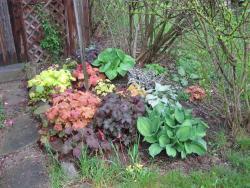How to Grow and Care for Coral Bells
Introduction
Coralbells sport airy flower spikes on wiry stems above low-growing, often dramatic foliage. Varieties with variegated or dark purple leaves make stunning ground covers, and the delicate flower spikes won't obscure the plants behind them, making them a good choice for the front of the border. Another common name is alum root.
Heuchera Propagation by Leaf Cuttings
Heuchera from leaf cuttings.
Note: Some plants are patented. Please check to see that the variety of plant you are taking cuttings from is not covered by these patents. This information can be obtained from USPTO (United States Patent and Trademark Office)
If it is a newer heuchera introduction, it is probably patented. Some of these varieties will hit the patent websites in a matter of a few weeks or can take a couple of years.
1. Cuttings can be taken any time of year, however they do better in the Spring when it is cooler. This gives both the mother plant and the new baby plant time to recover and become established before Winter.
2. When removing the leaf cuttings from the mother plant, make sure you find the stem/petiole of the heuchera. It is critical to include this part in your cutting.
3. Remove leaf cuttings with a sharp knife, ensuring part of the stem is included in the cuttings.
4. Dip leaf cutting into a rooting hormone, tapping off any excess.
5. Plant leaf cuttings into a moistened mix of 50/50 perlite and peat moss. ‘Tent’ a clear plastic bag over the cutting, using wooden skewers to keep the plastic off the leaf cutting. Place pot and bag in a shaded area, ensuring cutting receives light, but not direct sunlight.
6. Check cuttings daily to make sure they do not dry out or mold and stay moist. In about 6-8 weeks, roots should start to form. A gentle tug on the cuttings will let you know when roots have started to form.
7. To ensure there are enough roots on the cuttings, wait several weeks after roots have started to form prior to starting process for hardening off cuttings. When completely hardened off, plant out in garden.
I had some discussions with Terra Nova Nurseries regarding this topic. They informed me that the new plants from this type of propagation will not grow very large as this type of propagation does not include any leaf buds. This makes these new smaller plants ideal for containers or to tuck into a small spot in your garden.

About coral bells
Most coralbells sport clouds of tiny, bell-shaped pink, coral, red, or white flowers in late spring or early summer. However, varieties grown primarily for their foliage may have insignificant blooms. Foliage colors include red, purple, silver, as well as green, and some varieties sport marbled or patterned leaves. Foliage height ranges from 6 to 18 inches; flower spikes can reach 24 inches tall.
Special features of coral bells
Easy care/low maintenance
Unusual foliage
Good for cut flowers
Attracts hummingbirds
Ongoing Care
Remove dead foliage in early spring, then apply a thin layer of compost, followed by a 2-inch layer of mulch to retain moisture and control weeds. Water plants during the summer if rainfall is less than 1 inch per week. Cut back flower stalks after blooms fade. Divide plants in early spring every three or four years or when the stems become woody or the plant falls open at the center. Lift plants, divide the rootball into clumps, and replant.
Choosing a site to grow coral bells
Select a site with full sun to light shade and well-drained soil. In areas with hot summers, light shade is preferred.
Planting Instructions
Plant in spring or fall, spacing plants 1 to 2 feet apart depending on the variety. Prepare the garden bed by using a garden fork or tiller to loosen soil to a depth of 12 to 15 inches, then mix in a 2- to 4-inch layer of compost. Dig a hole twice the diameter of the plant's container. Carefully remove the plant from its pot and place it in the hole so the top of the rootball is level with the soil surface. Carefully fill in around the rootball and firm the soil gently. Water thoroughly.